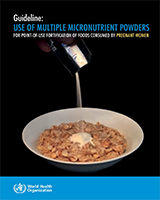Background
Pregnant women are particularly vulnerable to vitamin and mineral deficiencies because of the increase in metabolic demands to meet fetal requirements for growth and development. It is estimated that 38.2% of pregnant women (aged 15–49 years) worldwide are anaemic and that iron deficiency anaemia represents approximately 60% of these cases in non-malarious areas and 50% in malaria-endemic settings. Vitamin and mineral deficiencies in pregnancy are associated with adverse health outcomes in both the mother and her neonate.
Purpose of the guideline
Member States have requested guidance from the World Health Organization (WHO) on the effects and safety of the use of multiple micronutrient powders for point-of-use1 fortification of foods consumed by pregnant women. This guideline is intended to help Member States in their efforts to make evidence-informed decisions on the appropriate nutrition actions to improve the nutritional status of pregnant women. It will also support their efforts to achieve the Sustainable Development Goals (2), the global targets set by the Comprehensive implementation plan on maternal, infant and young child nutrition (3) and the Global strategy for women's, children's, and adolescents' health 2016–2030 (4).
The guideline is intended for a wide audience, including governments, nongovernmental organizations, health-care workers, scientists and donors involved in the design and implementation of micronutrient programmes and antenatal care services and their integration into national and subnational public health strategies and programmes.
Guideline development methodology
WHO developed the present evidence-informed recommendation using the procedures outlined in the WHO handbook for guideline development (5). The steps in this process included: (i) identification of priority questions and outcomes; (ii) retrieval of the evidence; (iii) assessment and synthesis of the evidence; (iv) formulation of recommendations, including research priorities; and (v) planning for dissemination implementation, impact evaluation and updating of the guideline. The Grading of Recommendations Assessment, Development and Evaluation (GRADE) methodology was followed (6), to prepare evidence profiles related to prioritized questions, based on up-to-date systematic reviews.
The guideline development group – nutrition actions 2013–2014 consisted of content experts, methodologists, and representatives of potential stakeholders and beneficiaries. The first meeting to scope the guideline was held on 18–21 February 2013, Geneva, Switzerland. The second meeting on 23–26 June 2014, Geneva, Switzerland, aimed to examine the evidence and assess the results of the systematic review. The third and final meeting on 3–6 November 2014, Cancun, Mexico, was held to finalize the formulation of the recommendation and the research priorities. External experts, as resource persons, assisted the guideline development group during the guideline development process, in presenting the evidence and contributing to the identification of research priorities. All meeting participants completed a declaration of interests form before each meeting. The final guideline document was peer-reviewed by two experts.
Available evidence
The systematic review included two trials. One trial, involving 478 pregnant women, assessed micronutrient powders for point-of-use fortification of foods versus iron and folic acid supplements. The other trial, involving 470 pregnant women, assessed micronutrient powders for point-of-use fortification of foods versus the same multiple micronutrients in supplements. No trials that assessed the other comparisons were found. Both trials took place in rural settings, one in Bangladesh and the other in Mexico. Neither of the included trial settings was endemic for malaria. The overall quality of evidence was very low and there was no evidence available for the majority of critical and important outcomes. Maternal adherence to micronutrient powders was reported to be lower than adherence to iron and folic acid supplementation (risk ratio [RR]: 0.76; 95% confidence interval [CI]: 0.66 to 0.87; n = 405). There were no significant differences in the prevalence of maternal anaemia at term or near term between multiple micronutrient supplements and multiple micronutrient powders containing the same micronutrient (RR: 0.92; 95% CI: 0.53 to 1.59; n = 470, very low quality evidence).
Recommendation
This recommendation is based on the very limited evidence to directly assess the potential benefits or harms of the use of point-of-use fortification with multiple micronutrient powders in pregnant women for improving maternal and infant health outcomes.
Remarks
Evidence to date shows no added value of multiple micronutrient powders over iron and folic acid supplementation in pregnant women.
An efficient system for the routine collection of relevant data, including therapeutic adherence and measures of programme performance, is critical to ensure supplementation programmes are effective and sustained, especially for iron and folic acid supplementation (
7,
8).
Monitoring is key to identifying barriers that might be sustaining unequal access to antenatal care, including iron and folic supplementation. Sustained implementation and scale-up largely benefit from appropriate monitoring mechanisms.
The WHO Secretariat will continue to follow the research development in the area of micronutrient supplementation for pregnant women. If the guideline merits an update, or if there are concerns about the validity of the guideline, the Department of Nutrition for Health and Development will coordinate the guideline update, following the formal procedures of the WHO handbook for guideline development (5).
As the guideline nears the 10-year review period agreed by the guideline development group, the Department of Nutrition for Health and Development at the WHO headquarters in Geneva, Switzerland, along with its internal partners, will be responsible for conducting a search for new evidence. WHO welcomes suggestions regarding additional questions for evaluation in the guideline when it is due for review.
- 1
Point-of-use fortification with multiple micronutrient powders refers to the addition of powders containing vitamins and minerals to energy-containing foods at home or in any other place where meals are to be consumed, such as schools, nurseries and refugee camps (1).

